A workout routine is a systematic exercise program focusing on different fitness goals, types of activities, or training modalities within a specific timeframe. Following a structured workout routine becomes imperative as per the 2022 study by Yasuo Terauchi, from Yokohama City University becasue it provides guidance on the exercise selection, training volume, and exercise progression, which is the key to consistent management of the metabolic syndrome.
A well-structured workout plan provides a clear roadmap for individuals, outlining what to do when to do it, and how to do it. This eliminates guesswork and can significantly increase adherence to the exercise routine.
According to a 2008 study by James H. Rimmer from the University of Illinois at Chicago, 57% of participants reported the lack of a structured exercise routine as a barrier to physical activity, as illustrated in this graph.
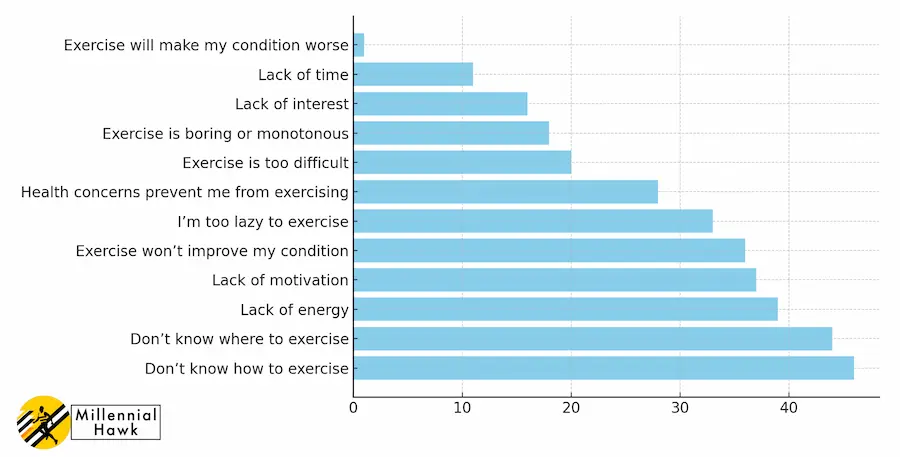
Having a set workout plan can address common barriers to exercise such as lack of time, motivation, and understanding of the exercise procedure. This workout routine would include exercise prescription for intensity, duration, frequency, periodization, and type.
The main benefit of using a comprehensive workout plan is that it allows for the balanced development of all components of physical fitness, thus leading to overall health improvement via reduced body fat percentage, increased muscle mass, improved heart rate, and blood pressure, better flexibility scores, and enhanced mood or mental health scores.
The main effect of this benefit is improved overall health and well-being. This includes a lower risk of chronic diseases such as heart disease and diabetes, improved mental health, increased energy levels, better sleep, and an enhanced quality of life.
This article covers the following 9 steps on how to start and build a workout plan, as well as addressing questions about the types of workout routines, their variations, benefits, structuring, and the frequency of changes.
- Conduct a Needs Analysis
- Select the Exercises
- Decide on Training Frequency
- Establish Exercise Order
- Determine Training Intensity
- Set Exercise Duration
- Define Training Load and Repetitions
- Calculate Training Volume
- Plan for Exercise Progression
1. Conduct a Needs Analysis
The needs analysis in exercise routine is a systematic process of identifying and evaluating the needs, requirements, and fitness goals of an individual or an athlete. It is a two-fold process that firstly examines the specific characteristics and requirements related to the sport, activity, or fitness goal of the individual.
According to a 2015 study by Amerigo Rossi from Columbia University Teachers College, the first step in a needs analysis includes identifying limitations, assessing common injuries, and understanding the requirements for different exercises and ranges of motion. The second step involves profiling the individual by evaluating their physical condition, training status, and primary goal of training. To help with this, the following table classifies training status into three categories: beginners, intermediate, and advanced.
| Training Status | Background | Current Program | Frequency (Per Week) | Training Stress | Technique Experience |
|---|---|---|---|---|---|
| Beginner (untrained) | Not training or just began training | < 2 months | ≤ 1-2 | None or low | None or minimal |
| Intermediate (moderately resistance trained) | Currently training | 2-6 months | ≤ 2-3 | Medium | Basic |
| Advanced (well resistance trained) | Currently training | ≥ 1 year | ≥ 3-4 | High | High |
Physical evaluation involves assessing various aspects of individual physical abilities, such as strength, flexibility, power, speed, and endurance. The tests selected should be relevant to one’s sport and skill level and based on available equipment.
After testing, the results are compared to normative data to identify strengths and weaknesses. This information is used to develop a training program that addresses deficiencies and enhances the person’s performance.
This analysis is crucial as it can effectively guide the development of a tailored and targeted exercise program that accounts for the unique needs and context of an individual.
2. Select the Exercises
According to a 2022 study by Diego A. Bonilla titled “Exercise Selection and Common Injuries in Fitness Centers,” exercise selection is crucial in a workout routine as it directly impacts both the effectiveness of the training and the risk of injury.
Exercise selection refers to the process of choosing specific exercises for an individual’s workout routine, taking into consideration the type and mode of exercise. The type of exercise can be compound or single-joint based on the primary muscle groups involved, their contribution to the sport movement, and the need for muscular stabilization, as shown in this diagram.
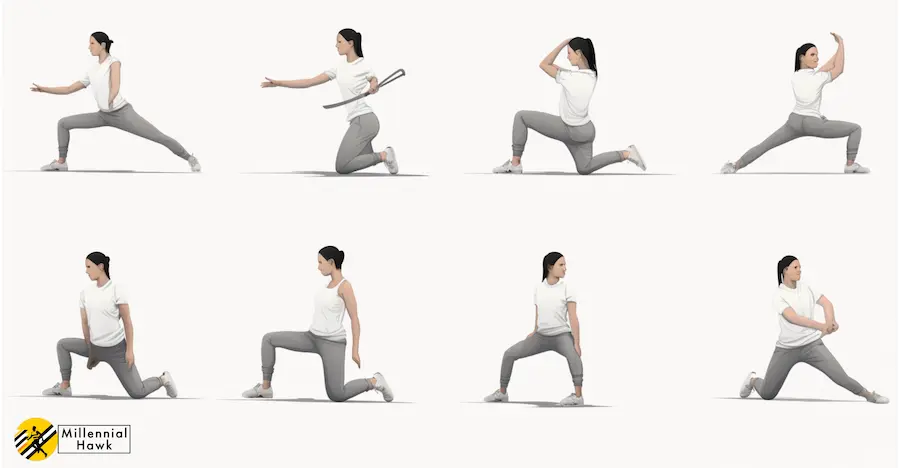
The selected exercises should mimic the sport’s movement patterns to ensure a positive transfer and maintain muscular balance.
The exercise mode, on the other hand, specifies the particular activity the individual performs such as cycling, running, swimming, etc. To enhance aerobic endurance performance, athletes should select activities that closely replicate the movement pattern used in competition.
This promotes positive adaptations in specific physiological systems, challenges the recruitment of specific muscle fibers, and induces adaptations in the energy systems within those fibers.
Rehabilitation or injury prevention can be facilitated by assistance exercises that focus on smaller muscle areas or single joints. For example, if a person is prone to shoulder injuries, their workout plan may include specific exercises to strengthen the rotator cuff muscles.
When selecting exercises, it is important to consider the availability of exercise equipment. If certain equipment is lacking, exercises that are not as sport-specific may need to be chosen. For example, if there are no Olympic-type barbells with revolving sleeves, exercises like the power clean cannot be done.
Similarly, if there is a shortage of barbell plates, exercises that require less resistance may need to be substituted.
3. Decide on Training Frequency
Exercise frequency refers to the number of exercise or training sessions conducted within a certain time period, typically per week. Exercise frequency is a key variable in the design of an optimal exercise routine, as per a 2016 study by Brad J. Schoenfeld from Lehman College.
In his research titled “Effects of Resistance Training Frequency on Measures of Muscle Hypertrophy,” higher frequency of training was associated with greater hypertrophy effect size. It also concluded that training major muscle groups at least twice a week promotes superior hypertrophic outcomes compared to training once a week.
How often should you train depends largely on your individual fitness level or training status. For beginners, a lower frequency, typically three days per week, is generally recommended to allow for sufficient rest and recovery, as illustrated in this graph.
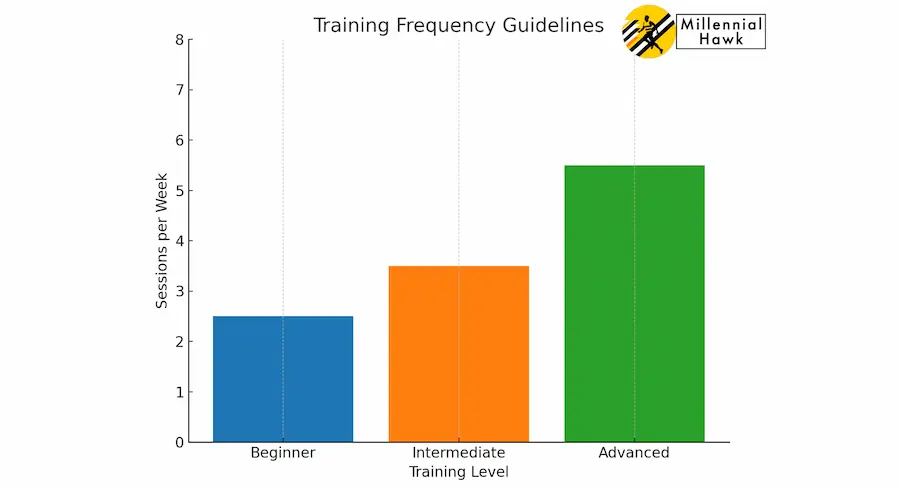
As one’s fitness level improves and they transition to intermediate or advanced training status, the frequency can be increased. This can optimize the training stimulus and lead to greater improvements in fitness and performance.
If the exercise frequency is too low, the individual may not experience the desired fitness adaptations and improvements in performance.
Training stimuli may not be sufficient to induce changes in the body’s muscular strength, endurance, power, or cardiovascular fitness. Furthermore, consistency in training can be compromised, making it difficult to establish and maintain a regular exercise habit. On the other hand, if the frequency of exercise is too high, it can lead to overtraining.
4. Establish Exercise Order
Exercise order refers to the sequence or arrangement of exercises performed during a training session. It considers how one exercise affects the performance and technique of subsequent exercises.
Common methods of arranging exercises include performing compound exercises before assistance exercises, alternating between upper and lower body exercises, or alternating between “push” and “pull” exercises. Each method aims to maximize performance while minimizing fatigue and the risk of injury.
Exercise order is crucial because it can influence the effectiveness of the workout and the achievement of training goals.
According to a 2021 study by João Pedro Nunes from Londrina State University, exercise order did not have a significant effect on hypertrophy, but it did on strength gains. Starting with multi-joint exercises results in greater strength gains while starting with single-joint exercises yielded better results for strength gains in those exercises. Proper exercise order also aids in achieving the desired training stimulus and reduces the risk of injury by ensuring that the athlete is not overly fatigued when performing exercises that require good technique or high strength output.
An optimal exercise order can enhance the quality of each training session, leading to more productive workouts, improved efficiency, and better fitness outcomes. Conversely, poor exercise order can negatively affect the quality and effectiveness of a workout. If you begin a workout with less demanding exercises and leave the more demanding or complex ones for later, you could experience excessive fatigue by the time you reach these exercises.
5. Determine Training Intensity
A successful endurance workout plan involves manipulating training intensity to maximize performance and minimize negative outcomes, as per a 2010 study by Stephen Seiler from the University of Agder.
Training intensity refers to the level of effort required in a particular exercise session. It is a central aspect of an exercise program as it fundamentally determines the methods employed to stress the body’s systems to induce desired physiological adaptations.
Typically, about 80% of training sessions are performed at low intensity (LISS workout routine), with 20% consisting of high-intensity work (HIIT workout routine), as illustrated in this chart.
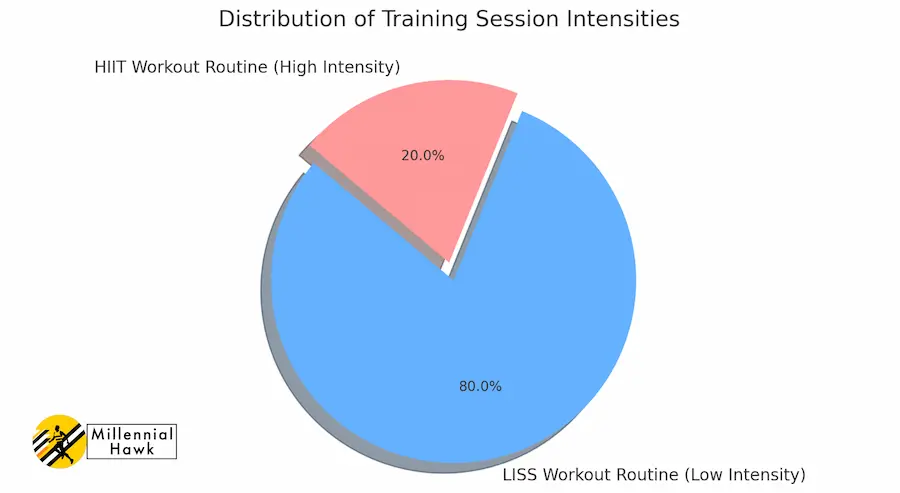
Endurance athletes tend to prioritize high-volume training with intermittent high-intensity training. Studies show that increasing the emphasis on high-intensity interval training for well-trained athletes does not necessarily lead to long-term performance gains. The combination of low-intensity and long-duration training with occasional high-intensity bouts may optimize adaptive signaling and technical mastery while managing stress levels.
Four primary methods are commonly used to measure exercise intensity: monitoring oxygen consumption during exercise to calculate its percentage of VO2 max, measuring blood lactate concentration, using heart rate monitoring, or ratings of perceived exertion (RPE).
In cases where such scientific measures are not accessible, relative measures such as metabolic equivalents (METs), exercise velocity, or subjective measures like perceived exertion can be utilized.
This table shows metabolic equivalent values for a variety of physical activities.
| METs | Activity |
|---|---|
| 1.0 | Lying or sitting quietly, doing nothing, lying in bed awake |
| 2.0 | Walking, <2 miles per hour (<3.2 km/h), level surface |
| 2.5 | Walking, 2 miles per hour (3.2 km/h), level surface |
| 3.0 | Resistance training, light or moderate effort |
| 3.5 | Stationary cycling, 30-50 W, very light effort |
| 3.0 | Walking, 2.5 miles per hour (4 km/h) |
| 3.5 | Walking, 2.8-3.2 miles per hour (4.5-5.2 km/h), level surface |
| 3.5 | Calisthenics, home exercise, light or moderate effort |
| 4.3 | Walking, 3.5 miles per hour (5.6 km/h), level surface |
| 4.8 | Stair stepping (with a 4-inch step height), 30 steps per minute |
| 5.0 | Aerobic dance, low impact |
| 5.0 | Walking, 4 miles per hour (6.4 km/h), level surface |
| 5.0 | Elliptical trainer, moderate effort |
| 5.5 | Step aerobics (with a 4-inch step height) |
| 5.5 | Water aerobics, water calisthenics |
| 5.8 | Swimming laps, freestyle, slow, moderate or light effort |
| 6.0 | Outdoor cycling, 10 to 11.9 miles per hour (16.1-19.2 km/h) |
| 6.0 | Swimming laps, freestyle, slow, moderate, or light effort |
| 6.3 | Stair stepping (with a 12-inch (31 cm) step height), 20 steps per minute |
| 6.3 | Walking, 4.5 miles per hour (7.2 km/h), level surface |
| 6.8 | Stationary cycling, 90-100 W, light effort |
| 6.9 | Stair stepping (with an 8-inch step height), 30 steps per minute |
| 7.0 | Rowing, stationary, 100 W, moderate effort |
| 7.3 | Aerobic dance, high impact |
| 7.5 | Step aerobics (with a 6- to 8-inch step) |
| 8.0 | Calisthenics (e.g., push-ups, sit-ups, pull-ups, jumping jacks), vigorous effort |
| 8.0 | Circuit training, including some aerobic stations, with minimal rest |
| 8.0 | Outdoor cycling, 12 to 13.9 miles per hour (19.3-22.4 km/h) |
| 8.3 | Walking, 5 miles per hour (8.0 km/h) |
| 8.5 | Rowing, stationary, 150 W, moderate effort |
| 8.8 | Stationary cycling, 101-160 W, moderate effort |
| 9.0 | Running, 5.2 miles per hour (8.4 km/h) (11.5 minutes per mile) |
| 9.0 | Stair aerobics (with a 10-12-inch step height) |
| 9.8 | Running, 6 miles per hour (9.7 km/h) (10 minutes per mile) |
| 9.5 | Step aerobics (with a 10- to 12-inch step) |
| 9.8 | Swimming laps, freestyle, fast, vigorous effort |
| 10.0 | Outdoor cycling, 14 to 15.9 miles per hour (22.5-25.6 km/h) |
The effect of exercise intensity on an individual’s workout is highly significant. Higher-intensity workouts can lead to greater cardiovascular and respiratory function, assist in recruiting more muscle fibers, and improve overall aerobic performance.
It bears a direct relationship with exercise adaptation, as greater intensity tends to cause more significant changes in the body’s muscular strength, endurance, and power.
The importance of exercise intensity in an exercise routine lies in its connection with the desired fitness outcomes. The appropriate intensity level elicits sufficient stress on the body to trigger the necessary physiological adaptations.
However, extreme values at either end of the spectrum can hinder progress. Too low of intensity does not sufficiently overload the body’s systems and thus may fail to induce any significant physiological adaptations.
Conversely, an overly high exercise intensity can result in premature fatigue, a subsequent early end to the training session, and an increased risk of injuries, leading to subpar and ineffective workout sessions.
6. Set Exercise Duration
Exercise duration refers to the length of time an individual engages in a physical activity or workout session. This can vary widely depending on the type of exercise, the person’s fitness level, goals, and availability.
The length of an exercise session can impact calorie burn, muscle development, endurance building, and cardiovascular health. For some goals, a longer duration may be beneficial, while for others, shorter, more intense workouts may be more effective.
As per the 1996 study by Stuart M. Phillips from McMaster University, exercise duration has a significant effect on how the body uses energy sources. In the study, male participants exercised 2 hours a day on a cycle for a total of 31 days.
After just 5 days, total fat oxidation during exercise increased by 10% due to an increase in intramuscular triglyceride oxidation (+63%) and a decrease in glycogen oxidation (-16%). At 31 days, total fat oxidation during exercise increased by a further 58%, as illustrated in this graph.
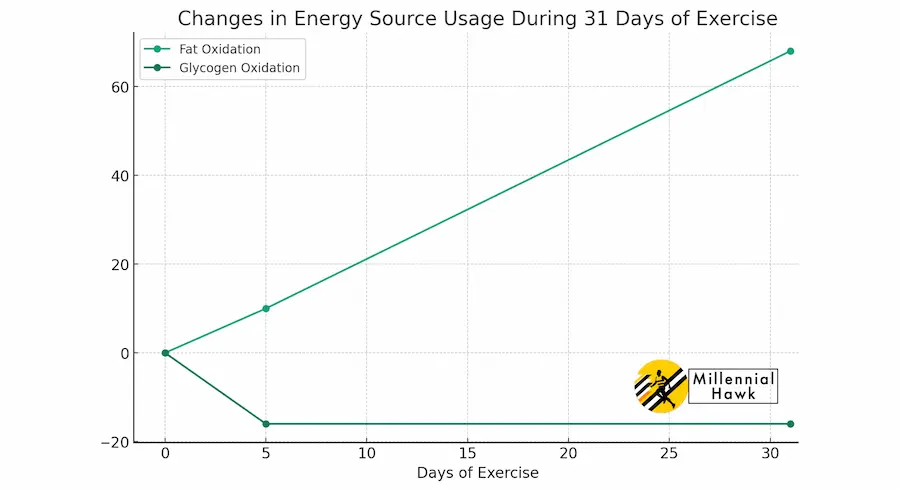
The study concludes that longer-duration training induces a progressive shift in energy use, featuring a greater reliance on fat sources within muscle tissue and a reduction in carbohydrate use.
7. Define Training Load and Repetitions
Training load refers to the amount of weight assigned to a specific exercise set in a resistance training program. It is often considered the most critical aspect of the program. In the context of Olympic weightlifting, the “load” is calculated by multiplying the weight lifted by the number of times it is lifted and summing all such values over a training session.
According to Jeremy M. Sheppard, this concept also extends to “volume load,” a term that relates to mechanical work and the associated metabolic energy demands and physiological stress. Volume load considers system mass volume load and helps in quantifying the nature of the total resistance training load.
For example, if a barbell weighing 100 weight units is lifted 2 vertical distance units for 15 repetitions, the total concentric mechanical work is 3,000 work units. However, the volume load, in this case, would be 1,500 units (not including the distance value) and would still relate directly to the amount of mechanical work performed and the extent of metabolic demand.
A repetition refers to the number of times an exercise can be performed. In resistance training, the term “repetition” often refers to performing a single complete movement of a particular exercise. Repetitions are part of sets, where a specific number of repetitions make up one set.
The relationship between load and repetitions is inversely related; the heavier the load, the lower the number of repetitions that can be performed. Focusing on one training goal implies the use of a certain load and repetition regimen.
The load can be described as a percentage of a 1-repetition maximum (1RM) or the most weight lifted for a specified number of repetitions, known as a repetition maximum (RM).
For instance, if athletes can perform 10 repetitions with 60 kg in the back squat exercise, the 10RM is 60 kg.
8. Calculate Training Volume
The definition of training volume, as per a 2021 study by Eneko Baz-Valle from the University of the Basque Country, refers to the total amount of work performed during a training session or over a specific training period.
It is typically quantified by considering factors such as the number of sets, repetitions, and weight used in each exercise. Training volume is an important variable to consider in resistance training, as it has been shown to have a significant impact on muscle hypertrophy and strength gains. By manipulating the total number of sets, athletes, and coaches can effectively adjust the training volume to optimize their desired training outcomes.
9. Plan for Exercise Progression
Exercise progression refers to the dynamic and systematic process of advancing or modifying an exercise program to meet individual needs, training goals, and targeted program objectives.
According to a 2004 study by William J. Kraemer from the University of Connecticut, progression in resistance training requires careful planning and evaluation. Proper goal targeting, exercise testing, technique, supervision, and prescription are all important for a successful resistance training program.
Depending on the fitness goals, progression may involve increasing the frequency, intensity, and duration of exercise. It is recommended to include at least one recovery or active rest day each week.
Progression should be gradual, with no more than a 10% increase in frequency, intensity, or duration per week. When it becomes difficult to increase frequency or duration, progression can still occur through intensity manipulation.
What is a Workout Routine?
A workout routine, as per the 2021 study by Henning Wackerhage from the Technical University of Munich, refers to an evidence-based plan or prescription for physical activity. It is based on current scientific evidence and includes various interacting interventions like exercises and nutritional recommendations.
The workout routine often changes over time due to methods like periodization or tapering. The adaptation to workout routines is often highly variable from person to person and requires personal testing and monitoring to ensure effectiveness.
This personalized approach acknowledges that sometimes the most effective workout may not align with the individual’s preferences, thus adjustments may be made to ensure compliance and satisfaction.
When asked what is a good workout routine, Jeremy M. Sheppard from the Canadian Sport Institute provides a comprehensive answer in chapter 17, “Program Design,” of the ‘Essentials of Strength Training and Conditioning‘ book.
He describes a good exercise plan as one that is tailored to the individual’s needs, aimed at enhancing strength, and addressing weaknesses. It should consider any physical limitations and provide a balanced mix of aerobic, anaerobic, and flexibility exercises.
What Are The Types of Workout Routines?
Numerous factors can shape the nature of workout routines. These include but are not limited to, aspects such as gender, age, available exercise equipment, fitness objectives, health status, location, and preferred training modalities.
Other influential factors include the duration and frequency of workouts, the muscle groups targeted, cost considerations, the time one can commit, the specific exercises chosen, the level of difficulty, any professional endorsements, the individual’s occupation, and the time of day for workouts, as illustrated in this graph.
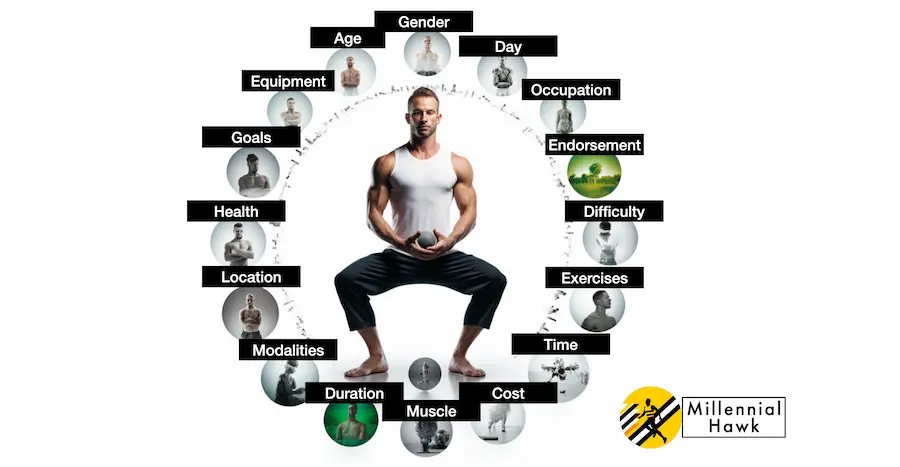
- Gender: Workout routines for men and women can differ significantly due to varying fitness goals, hormonal balances, and body compositions. These factors can influence the types of exercises that are most beneficial for each gender. In addition, there are specialized workout plans for women during the prenatal and postnatal stages, addressing the unique needs and conditions during these periods.
- Age Group: Different ages call for different workout routines. For instance, a workout program for individuals over 50 might emphasize lower-impact exercises, while a youth football offseason routine could handle more intense activities. This principle applies similarly to students who typically engage in more strenuous exercises.
- Available Exercise Equipment: A treadmill workout routine, an elliptical workout routine, a free weight workout routine, a kettlebell workout routine, a Peloton workout routine, or a Tonal workout routine all refer to the utilization of different exercise equipment available. This equipment, which includes machines, weights, and other tools, facilitates a variety of workout types, thereby influencing the overall exercise plan.
- Fitness Goals: The type of workout you choose depends on your fitness goal. This could include an exercise routine for weight loss, muscle building, or developing an hourglass figure. It could also be a specialized plan, such as a workout routine for weight gain, a training regimen tailored to football players, or a specific program designed for a marathon or 10k training.
- Health Considerations: Specialized workout plans, such as those designed to lower blood pressure, increase bone density, aid in hip replacement recovery, or alleviate back pain, are essential for individuals with certain health conditions, injuries, or disabilities. These conditions may limit the types and intensity of exercises one can do, thus necessitating tailored workout programs.
- Location: Workout routines can be adapted to various environments. You might choose an at-home workout routine, a regimented plan at the gym, an outdoor workout schedule, a workout plan suitable for a hotel room, or even a garage workout plan. Outdoor activities could encompass running or cycling, while indoor workouts could incorporate weightlifting or yoga.
- Training Modalities: A plyometric workout routine, HIIT (high-intensity interval training) workout routine, strength workout routine, cardio workout routine, and circuit training workout plan are different modalities that elicit various responses from the body. These routines depend on your fitness goals, whether you’re focusing on circuit training, high-intensity interval training (HIIT), or resistance training.
- Duration: A 7-day workout routine, 14-day workout routine, 30-day workout routine, 60-minute workout routine, or 90-day workout routine can be chosen. The length of the workout will depend on factors such as fitness level, goals, and available time.
- Target Muscle Groups: Arm workout routine, workout routine for abs, legs workout routine, chest day workout routine, lower body workout routine — these are all examples of targeted exercise plans. Different exercises target different muscles; someone looking to develop leg strength, for instance, will have a different routine compared to someone focusing on their arms or abs.
- Cost Considerations: An affordable gym workout plan, including free and cheap workout routines, takes into consideration the financial aspects of a workout plan. This might involve costs related to gym memberships, personal trainer fees, or the purchase of home exercise equipment
- Time Commitment: The 10-minute-a-day workout plan, the 20-minute HIIT workout routine, and the 5-minute ab workout routine are examples of exercise programs. They indicate the amount of time one can dedicate to exercising, whether it’s on a daily, weekly, or monthly basis. This factor helps tailor the routine to fit individual schedules.
- Specific Exercises Chosen: The selection of a workout routine, whether it’s a burpee workout, bench press workout routine, cycling workout, or rowing workout, relates to the particular activities and movements chosen. These choices reflect personal preferences, fitness goals, and health considerations.
- Level of Difficulty: A beginner workout routine or an advanced workout routine for lean muscle refers to the intensity and complexity of the exercises within the routines. Beginners may opt for a less challenging plan, while more advanced athletes might choose a routine with a higher level of difficulty.
- Professional Endorsements: Workout plans may include recommendations or affiliations with fitness experts, athletes, or other authorities in the field. Endorsements from famous people and celebrities can lend credibility to a workout routine and influence its adoption. Examples of celebrity-endorsed routines include the Jay Cutler workout routine, Khloe Kardashian workout routine, Chris Hemsworth workout routine, and Mike Mentzer workout routine.
- Individual’s Occupation: Military workout plans, Instagram model workout routines, astronaut workout plans, firefighter workout plans, UFC fighter workout routines, and police officer workout routines take into account the person’s job and daily responsibilities. These factors can affect the availability, energy levels, and specific needs for a workout routine.
- Time of Day for Workouts: A morning gym workout routine, an after-work workout routine, or an evening workout routine refers to the preferred time for exercising. These preferences may align with mornings, afternoons, or evenings, and are often influenced by individual preferences, energy levels, and daily schedules.
What Are The Different Types Of Workout Plans For Men?
There are a number of different specific workout plans for men based on their fitness goals. Here are some workout plans:
- Bulk-Building Workouts: These workouts are designed to maximize muscle mass. They might include high-resistance, low-repetition exercises, typically focusing on compound movements such as deadlifts, squats, and bench presses.
- Target Muscle Group Workouts: These are routines designed to enhance particular muscle groups. For example, there might be routines specifically designed to target the chest, arms, traps, and front deltoids.
- Full Body Workouts: These routines work out the entire body and are especially beneficial for men who want to get fit and build muscles overall.
- Strength Training: This involves exercises designed to increase muscle strength, often through resistance training such as weight lifting.
Men’s fitness goals are often shaped by a specific perspective on their bodies, which can differ markedly from how women perceive their own bodies. Many men aspire to a muscular and hairless physique, leading them to pursue exercises that enhance their physical bulk. This video shows a 2-day-per-week workout routine for men.
Their workouts tend to be targeted toward specific muscle groups, including routines for the chest, arms, traps, and front deltoids. These tailored routines reflect a common desire among men to develop a muscular appearance.
What Are The Different Types Of Workout Plans For Women?
Workout routines for women vary depending on the types of workout plans they might choose, and these choices are often influenced by their goals, preferences, and life stages.
- Health and Wellness: Many women choose workout routines related to improving their general health and wellness. This might include losing weight, improving cardiovascular health, increasing strength or flexibility, promoting mental health, or preventing disease.
- Pregnancy and Postnatal: A workout plan for pregnancy, along with postnatal exercises, is tailored to assist women both during and following pregnancy. These routines typically emphasize keeping fit while taking into account the specific physical alterations and requirements of women who are pregnant or have recently given birth.
- Busy Mom Workout Routines: Busy mom workout routines are designed to accommodate time constraints and multitasking demands. These routines can be done at home or in short time frames. They include home-based workouts using bodyweight exercises or household items, quick HIIT sessions, exercising with kids, online fitness classes, and incorporating fitness into daily routines.
According to a 2017 study by Michelle Segar from the University of Michigan, women’s fitness goals are closely tied to principles of self-determination theory, which emphasizes autonomy, competence, and relatedness. This video shows a 20-minute workout routine for women from Pamela Reif.
How do Workout Plans Differ for Older Adults Compared to Younger People?
The workout plans for older adults differ significantly compared to younger people. According to American Heart Association, the target heart rate for older adults should be 80-136 beats per minute compared to 100-170 beats per minute for younger adults.
In terms of equipment, dumbbell, and resistance band workout routines have been reported to provide effective, portable, and cost-effective means to enhance lower-body function and muscle quality in an aging population, according to a 2021 study by Ashley A. Herda from the University of Kansas-Edwards Campus.
What Type of Equipment Do I Need For an Effective Workout Plan?
The type of equipment you need for an effective workout plan depends on personal preferences, abilities, limitations, and injuries. Cardio equipment such as an exercise bike, treadmill, rower, or Peloton bike can be used for cardiovascular training.
Strength and resistance can be improved using dumbbells, barbells, or wall-mounted systems like the Tonal gym. Alternatively, there are various no-equipment exercises, or workout programs like yoga, pilates, or barre that only use body weight if you prefer not to use equipment or if you have certain limitations or injuries.
What are the Differences Between Home Workout Plans and Gym Workout Plans?
Home and gym workout plans vary mainly in equipment, training volume, and load, price, accessibility, types of training, and results. Gym workout plans often offer higher training volume and load with the plethora of machines and weights available, whereas home workouts may be limited by the amount of equipment like dumbbells or barbells you own.
In terms of price, gym plans can range anywhere from $10-$60 a month depending on the location and type of gym, whereas a home workout plan can cost anywhere from $50-$500 for equipment, but is free afterward.
Gyms provide more varied routines like push-pull-legs or gym machine workouts, whereas home workouts may focus more on dumbbell routines or calisthenics, and can offer more accessibility being available any time at your own home.
What is the Cost of the Workout Plan?
The cost of a workout plan can vary based on several factors. It can range from being free, especially for nonspecific or “one size fits all” plans found online, to more personalized plans developed by professionals. These comprehensive plans, which include all training variables, can generally cost around $100 per plan.
How Long Should You Do the Same Workout Session?
How long you should do the same workout session can vary greatly depending on the goals, individual adaptability, and the type of workout. As per a 2014 study by Rodrigo M Fonseca from the University of São Paulo, changing the type of strength exercises while keeping the intensity constant could be more effective for strength gains. However, as long as the training intensity reaches a certain threshold, muscle hypertrophy can be similar regardless of exercise variation.
Conversely, a 2022 study by Witalo Kassiano suggests that excessive variation or frequent changes in exercises may hinder muscular adaptations, implying the importance of consistency in a workout plan over a certain period.
How To Make a Workout Plan On Your Own?
To make a workout plan on your own, start by identifying your fitness goals such as weight loss, muscle gain, or increasing endurance. Select exercises that target your desired outcome and fit your current fitness level, ensuring to include a mix of cardiovascular exercises, strength training, and flexibility workouts. Create a schedule that designates specific days and times for your workouts, ensuring to include rest days for recovery.

